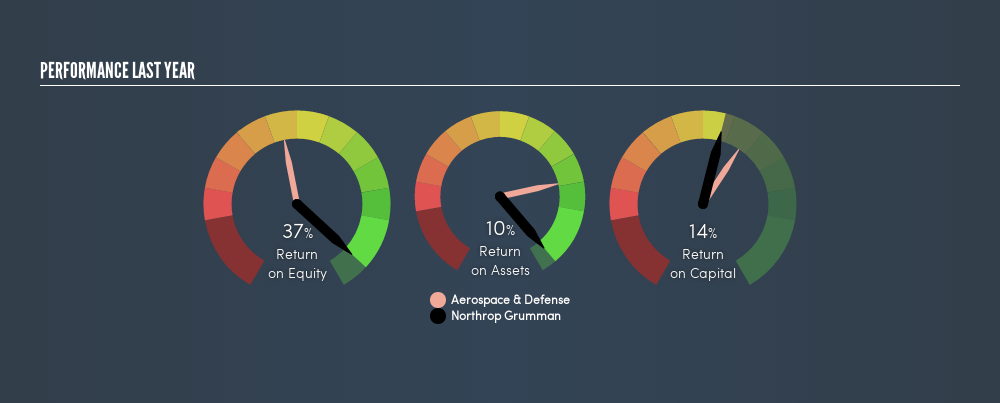- United States
- /
- Aerospace & Defense
- /
- NYSE:NOC
What Does Northrop Grumman Corporation’s (NYSE:NOC) 14% ROCE Say About The Business?

Want to participate in a short research study? Help shape the future of investing tools and you could win a $250 gift card!
Today we are going to look at Northrop Grumman Corporation (NYSE:NOC) to see whether it might be an attractive investment prospect. In particular, we'll consider its Return On Capital Employed (ROCE), as that can give us insight into how profitably the company is able to employ capital in its business.
First of all, we'll work out how to calculate ROCE. Second, we'll look at its ROCE compared to similar companies. Then we'll determine how its current liabilities are affecting its ROCE.
What is Return On Capital Employed (ROCE)?
ROCE is a metric for evaluating how much pre-tax income (in percentage terms) a company earns on the capital invested in its business. Generally speaking a higher ROCE is better. In brief, it is a useful tool, but it is not without drawbacks. Author Edwin Whiting says to be careful when comparing the ROCE of different businesses, since 'No two businesses are exactly alike.'
So, How Do We Calculate ROCE?
Analysts use this formula to calculate return on capital employed:
Return on Capital Employed = Earnings Before Interest and Tax (EBIT) ÷ (Total Assets - Current Liabilities)
Or for Northrop Grumman:
0.14 = US$4.2b ÷ (US$40b - US$8.8b) (Based on the trailing twelve months to March 2019.)
So, Northrop Grumman has an ROCE of 14%.
View our latest analysis for Northrop Grumman
Is Northrop Grumman's ROCE Good?
ROCE is commonly used for comparing the performance of similar businesses. It appears that Northrop Grumman's ROCE is fairly close to the Aerospace & Defense industry average of 12%. Independently of how Northrop Grumman compares to its industry, its ROCE in absolute terms appears decent, and the company may be worthy of closer investigation.

When considering this metric, keep in mind that it is backwards looking, and not necessarily predictive. Companies in cyclical industries can be difficult to understand using ROCE, as returns typically look high during boom times, and low during busts. This is because ROCE only looks at one year, instead of considering returns across a whole cycle. Since the future is so important for investors, you should check out our free report on analyst forecasts for Northrop Grumman.
Northrop Grumman's Current Liabilities And Their Impact On Its ROCE
Liabilities, such as supplier bills and bank overdrafts, are referred to as current liabilities if they need to be paid within 12 months. Due to the way ROCE is calculated, a high level of current liabilities makes a company look as though it has less capital employed, and thus can (sometimes unfairly) boost the ROCE. To check the impact of this, we calculate if a company has high current liabilities relative to its total assets.
Northrop Grumman has total assets of US$40b and current liabilities of US$8.8b. Therefore its current liabilities are equivalent to approximately 22% of its total assets. Current liabilities are minimal, limiting the impact on ROCE.
The Bottom Line On Northrop Grumman's ROCE
This is good to see, and with a sound ROCE, Northrop Grumman could be worth a closer look. Northrop Grumman shapes up well under this analysis, but it is far from the only business delivering excellent numbers . You might also want to check this free collection of companies delivering excellent earnings growth.
For those who like to find winning investments this free list of growing companies with recent insider purchasing, could be just the ticket.
We aim to bring you long-term focused research analysis driven by fundamental data. Note that our analysis may not factor in the latest price-sensitive company announcements or qualitative material.
If you spot an error that warrants correction, please contact the editor at editorial-team@simplywallst.com. This article by Simply Wall St is general in nature. It does not constitute a recommendation to buy or sell any stock, and does not take account of your objectives, or your financial situation. Simply Wall St has no position in the stocks mentioned. Thank you for reading.
About NYSE:NOC
Northrop Grumman
Operates as an aerospace and defense technology company in the United States, the Asia/Pacific, Europe, and internationally.
Undervalued established dividend payer.
Similar Companies
Market Insights
Community Narratives





